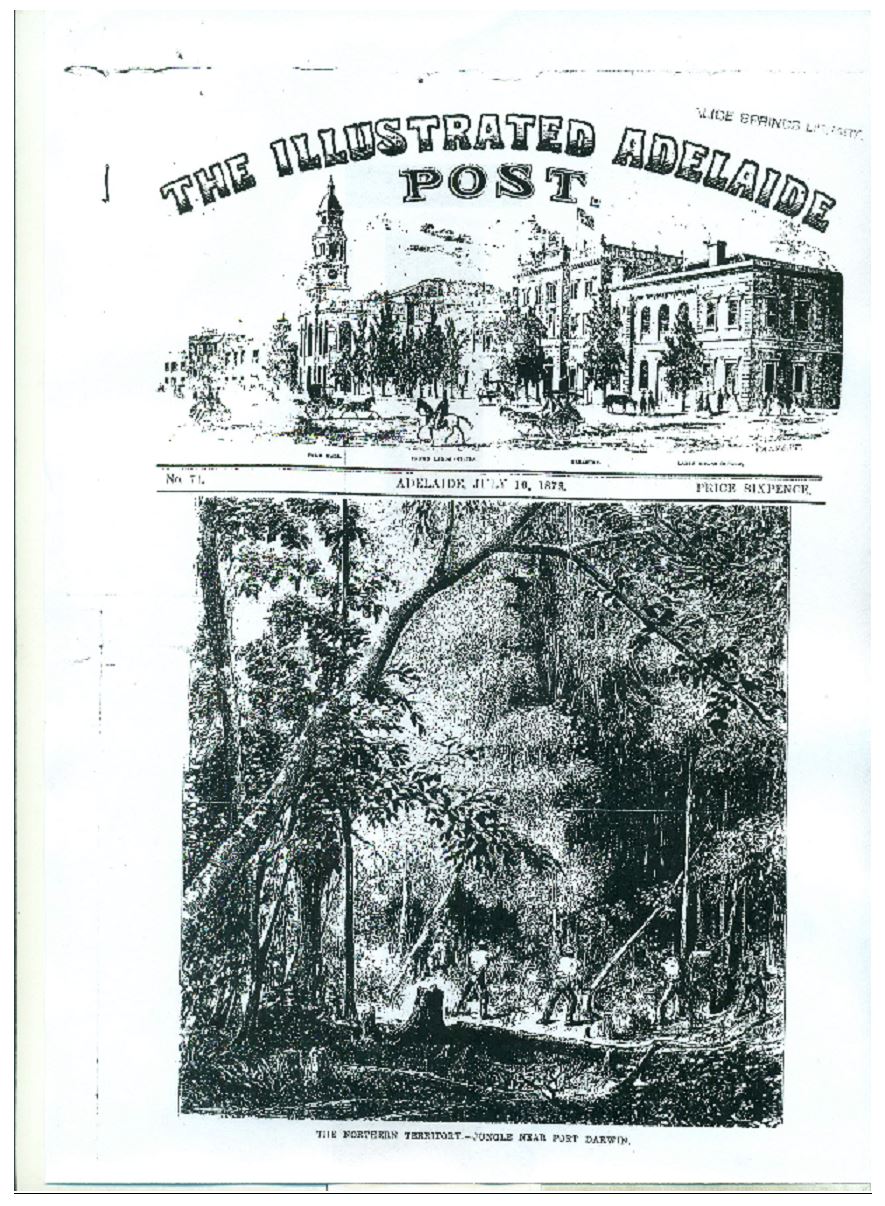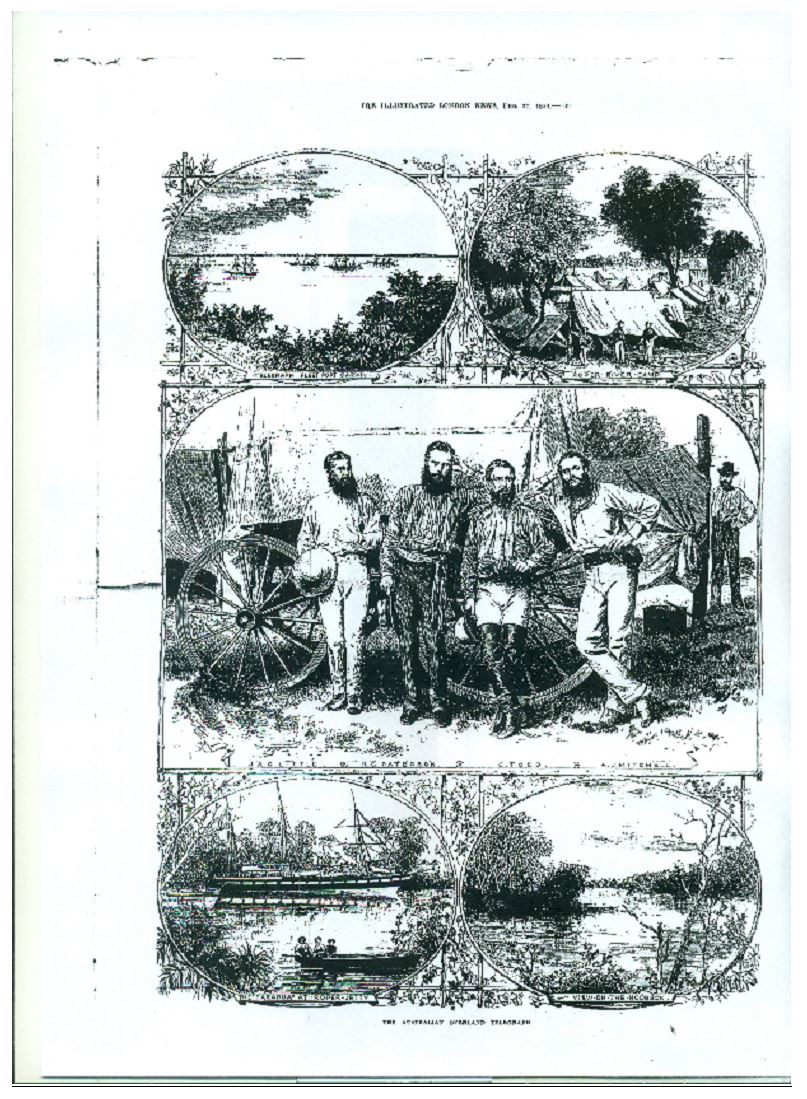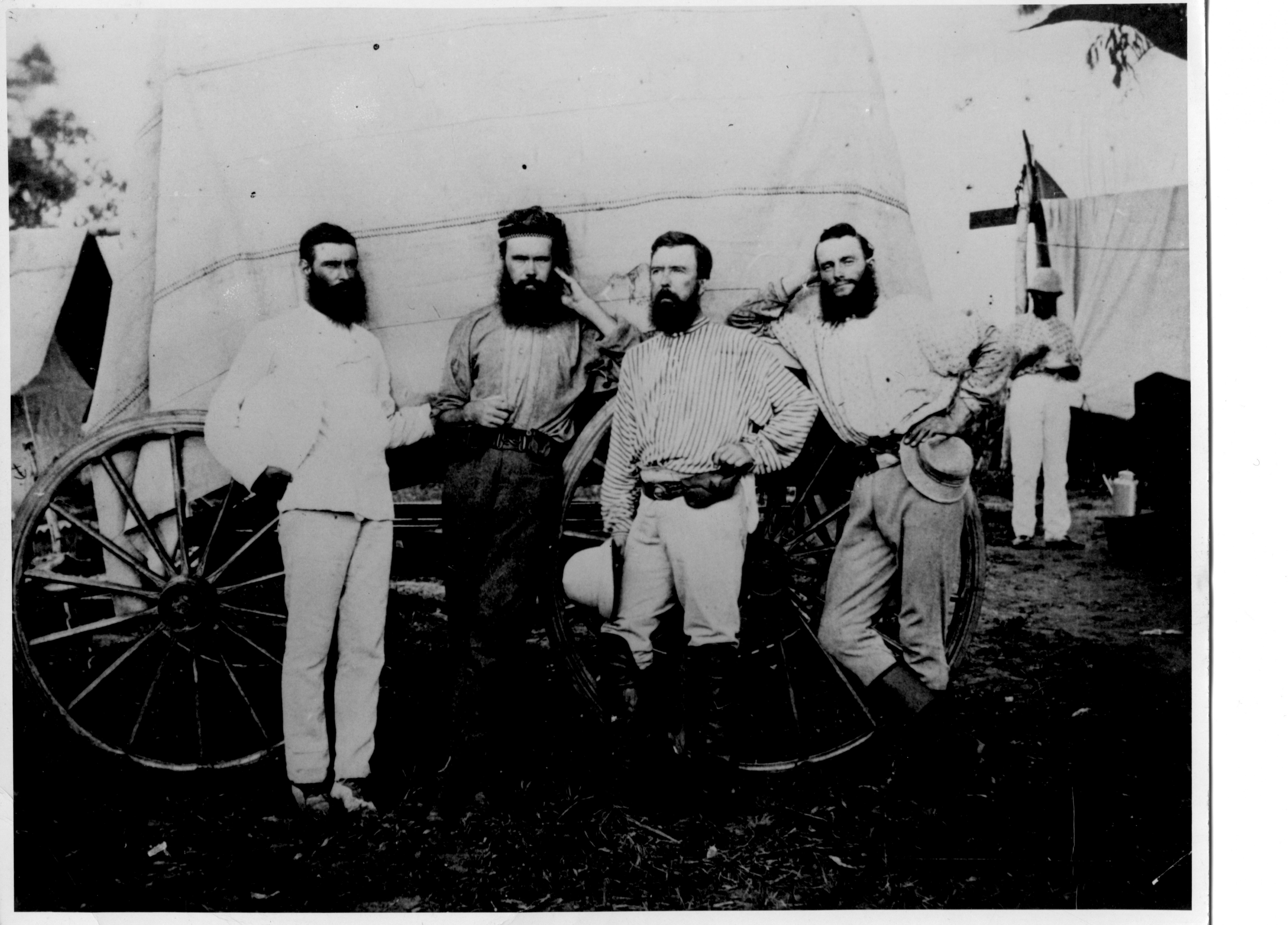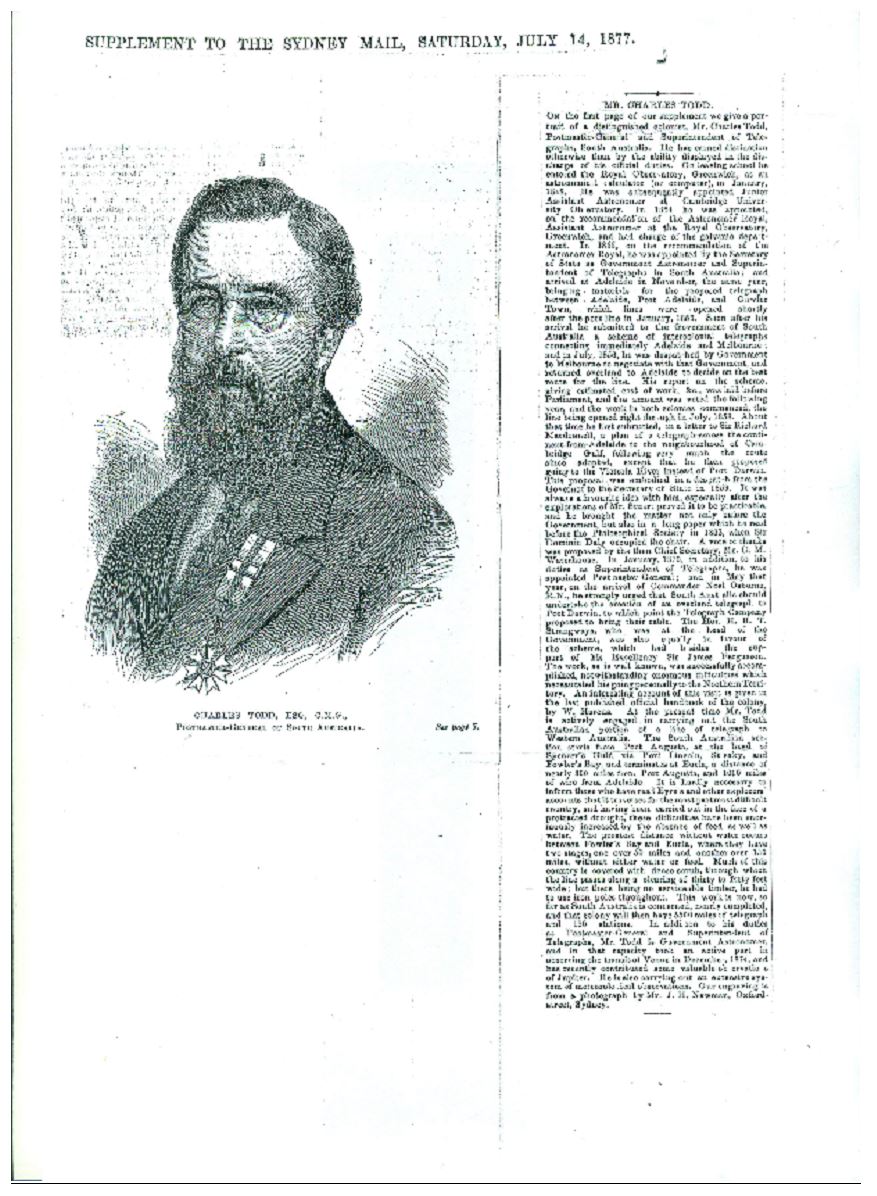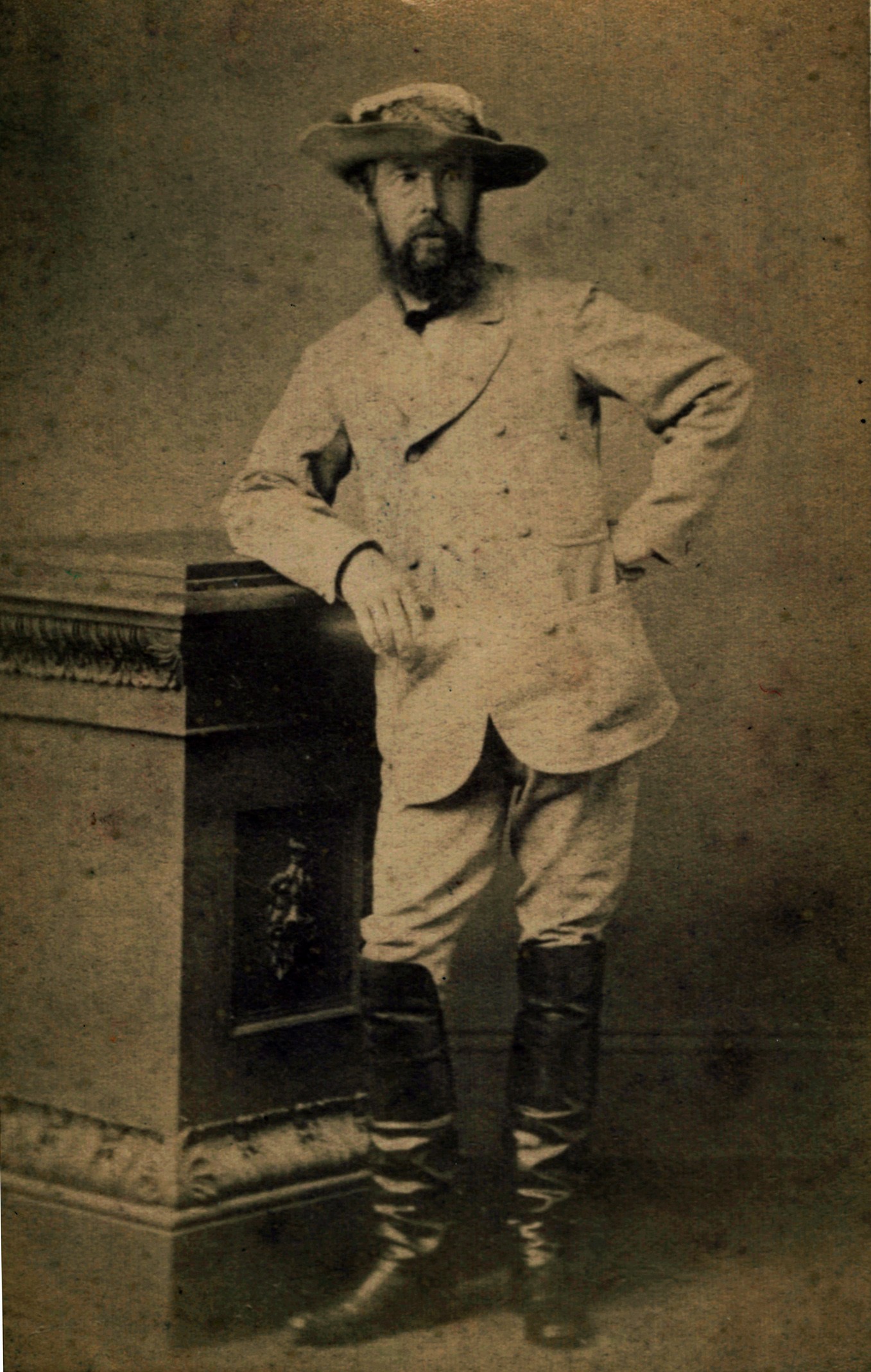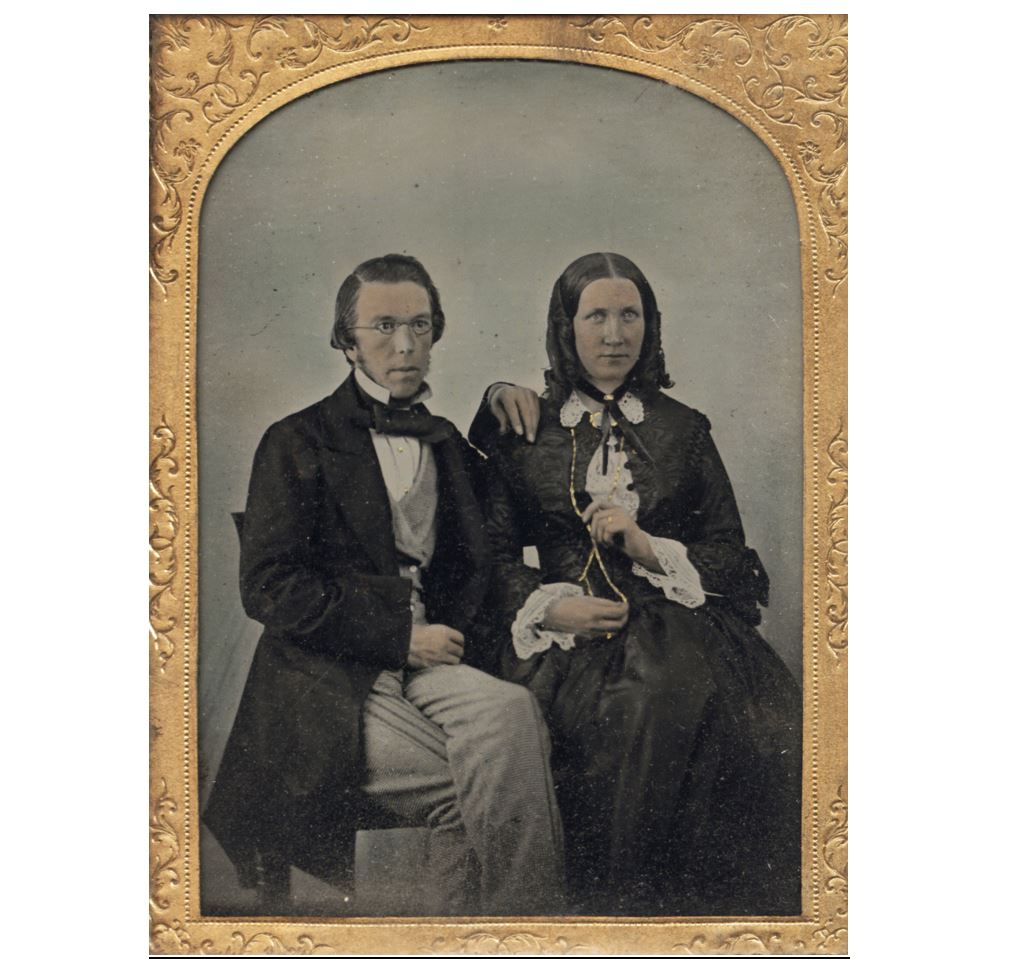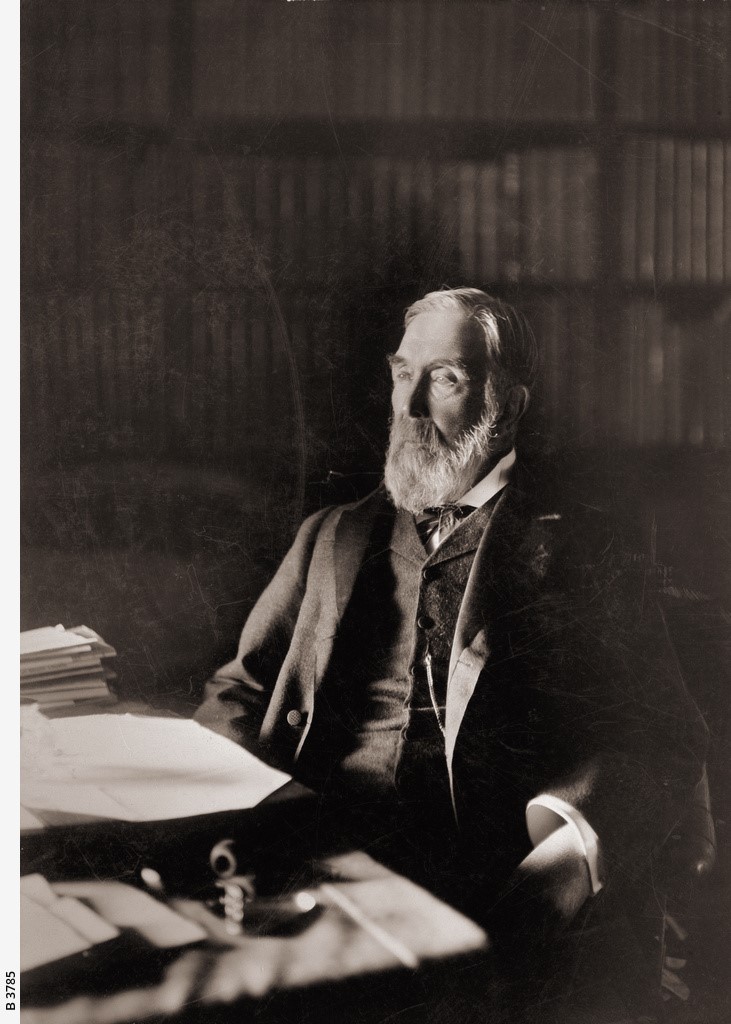Abstract
Sir Charles Todd is a seminal nineteenth-century figure who continues to fascinate popular writers and scholars alike, not least those working in modern telecommunications. A well-attended symposium, convened by Adelaide societies in August 2012, paid lengthy tribute to his wide-ranging achievements. In his own lifetime, 'Telegraph' Todd was celebrated for his achievement in planning and organising the construction of the Overland Telegraph Line from Adelaide to Darwin, linking Australia to the outside world. His personal intervention on the hazardous Northern Territory leg of the Overland Telegraph's construction was hailed as decisive in the successful completion of one of the great engineering feats of its day. Yet Todd himself has remained a shadowy figure, eluding a series of biographers for more than a century after his death. This article concerning the genesis of Todd's recent biography entitled Behind the Legend: The Many Worlds of Charles Todd, examines changing historical perspectives on Todd and his achievements. In particular, it identifies the increasing availability of biographical resources over time and reviews the challenges which biographers faced in bringing to life the career of a great pioneering Australian.
Introduction
In his own lifetime, 'Telegraph' Todd was most celebrated for his achievement in planning and organising the construction of the Overland Telegraph Line (OTL) from Adelaide to Darwin, linking Australia to the outside world. His personal intervention on the hazardous Northern Territory leg of the Overland Telegraph's construction, and his demonstrated capacity to overcome serious obstacles and flagging morale, were hailed as decisive in the successful completion of one of the great engineering feats of its day (Moyal 1984, p. 42). His rapid colonial recognition owed much to the heroic image which the colonial press subsequently projected of South Australia's prominent civil servant. For modern telecommunication writers like K. T. Livingston (1997, p. 8), the OTL episode remains significant in the public making of Todd, the colonial manager. It is on this basis that Donald Lamberton, in his 2000 Charles Todd Oration, acknowledges Todd as a skilled networker, a great people person and a good strategist tuned to political events (Lamberton 2001, p. 68).
In keeping with its biographical approach, this article overviews the extensive literature on Todd and the Overland Telegraph both during and after his lifetime. In the first instance, it shows how Todd's recognition owed something to other technologies like photography and newspaper illustration, before identifying the ways in which Todd was able to harness publicity during and after his 'great work'. In keeping with the fortunes of other great technological innovators, Todd's reputation has waxed and waned over time, while his remarkable service in the lead-up to federation has been too often written out of the national record. Yet, after his death in 1910, twentieth-century writers continued to mine the historical record, largely on the strength of Todd's own exemplary documentation, but also because collecting institutions have best preserved those records pertaining to his telegraphic work. Sustained in the professional literature for much of the twentieth-century, his reputation enjoyed a remarkable resurgence in the late twentieth century, when a combination of social and technological changes brought him once more to national prominence. Finally, in mapping this long personal trajectory, the article shows how interest in Todd's life and work continues to evolve into the twenty-first century.
This article concerning the genesis of Todd's recent biography entitled Behind the Legend: The Many Worlds of Charles Todd (Cryle 2017) examines changing historical perspectives on Todd and his achievements, including contributions on the subject to the Australian Journal of Telecommunications and the Digital Economy. In particular, it identifies the increasing availability of biographical resources over time and reviews the challenges which biographers faced in bringing to life the career of a great pioneering Australian.
The Making of a Colonial Icon
Todd's rapid recognition in the 1870s was aided by the rise of newspaper illustration in metropolitan weeklies such as the Australasian and Town and Country Journal, which contributed to the wide dissemination of photographs of his Northern Territory expedition. Although photographs could not be easily reproduced in colonial newspapers, even after the half tone process was introduced in the twentieth century, detailed illustrations could be produced using woodcuts, a technical process lasting several days, during which the engraver set out to reproduce an original image as a pattern of engraved lines on the woodblock (Dowling 1999, p. 117).
This process of cultural transformation helped to transform colonial figures like Todd into heroes (Sebe 2009). The success of explorers in Australia was nevertheless ambivalent, constrained by the harsh climate and often by the assistance or aggression of their Aboriginal hosts. In the mid-colonial period, both Burke and Wills and Leichhardt's transcontinental ambitions ended in tragedy, while John McDouall Stuart, repulsed by the Aborigines on at least one occasion, and desperately ill on his final return journey from northern Australia, achieved only a pyrrhic victory after his strenuous and repeated attempts. Yet it was the 'scientific legacy' of such explorers (Sebe 2009, p. 43), captured in Stuart's accurate maps and surveys of the interior, which provided an opportunity for Todd, allowing him to follow Stuart's tracks across the Australian continent when constructing the international telegraph link. Although explorers such as Stuart and Leichhardt ranked highest in colonial importance, Todd's rapid advance across central Australia with large numbers of workers, construction materials and supplies, constitutes a no less remarkable nineteenth-century achievement. For the establishment of the Overland Telegraph Line, in turn, opened the way for more extensive exploration of the Centre and the West, much of it undertaken by those who worked under Todd.
Todd as Publicist and Information Manager
Along with family letters and photos, newspapers provided Todd and his officers with valuable reading matter during their isolation at the Roper landing in the Northern Territory. Personal correspondence with Alice confirms that Todd was undertaking a more detailed reading of the press than simply following local happenings. He was at pains to request a wide cross section of newspapers, duly collected by family members and dispatched in a bag to him through the Adelaide Post Office (Todd, C. 1872). With the timely appearance of the Illustrated Adelaide Post, ahead of the illustrious Australasian Sketcher in Melbourne, Alice purchased the issue of 10 July 1872 and sent it on to Charles in the following month (Todd, A. 1872). It featured a series of northern scenes on the front page to whet local interest about the telegraph. At sixpence a copy, colonial and British pictorials were competitive with daily broadsheets, and proved just as effective as the attractive, but more expensive, landscape photographs taken by Captain Samuel Sweet, in replicating and publicising the visual iconography of the Roper River camp and the Overland Telegraph Line. Sweet accompanied Todd at a critical moment of the 1872 Northern Territory expedition during which, contrary to the advice of his ships captains, Todd ascended the flooded Roper River and established a depot from which to supply stranded inland construction teams.
Figure 1. The Northern Territory Jungle near Port Darwin, The Illustrated Adelaide Post, 10 July 1872
Within the Australian colonies, illustrated papers were quick to capitalise on the expectations surrounding Todd's northern achievements. In August 1872, the Illustrated Australian News led the way with a portrait of Todd, even before his successful return across inland Australia. By 1873, with the telegraphic link now open, the Australasian Sketcher (1873) circulated an illustration of Todd whom it asserted was now widely known beyond the limits of the colony for his zealous and able exertions on behalf of the Overland Telegraph. Illustrated papers like the Sketcher favoured visual symbols of colonial progress, be they railways, streetscapes, or images of rural settlement (Dowling 1999, p. 121). In keeping with this preoccupation, the Sketcher published an illustration of the Alice Springs telegraph station before turning its attention to Todd's essential role. His epic telegraph, straddling the continent, exercised a dual fascination as an example of a modern technology established in an inhospitable rural environment.
By early 1873, news of Todd's success had reached the pages of the Illustrated London News, a title mentioned in Alice's and Charles' correspondence. Since 1842, the weekly Illustrated London News had pioneered the new art of visual journalism and become a model for colonial press imitators. The second page of its February article was given over entirely to illustrations, with landscape sketches of the Roper camp and telegraph vessels grouped around a larger woodcut reproduction of the iconic Todd photograph. While not simply a promotional piece about Todd, it confirmed his leadership role in the Overland Telegraph Line, in the first instance as the instigator, but primarily as the executor whom neither the shipwreck of his stores, nor the difficulty of struggling across a flooded country could daunt (Illustrated London News, 1873).
In the United Kingdom, as in Australia, the Todd legend was growing, in spite of opposition from Queensland critics and the carping of Patterson, Todd's northern overseer. Yet if Todd had been responsible for supplying this material from his own archive, as his correspondence suggests, he made no serious attempt to steal the limelight. As South Australia's Postmaster General, he belonged to the civil service, an occupation which, despite its significant historical contribution, has received little in the way of historical or popular recognition. Within this group, Todd would emerge, however, as a notable exception, adept at exploiting the telegraphs capacity for rapid communication between government and the press. An example of his willingness to keep the public informed, from the field as well as the office, was Todd's use of a pocket relay in central Australia to tap into the completed transcontinental line and acknowledge messages of congratulations from around Australia. Predictably, however, the intensity of newspaper coverage, extending as it did beyond South Australia, attracted its share of criticism, most notably at the hands of the Sydney Morning Herald (1872) and the Brisbane Telegraph (1872), which fuelled rumours about the impending failure of the new Line. It would take Todd considerable time to quell the doubts and envy of rivals and collaborators, through a mixture of public refutation and private correspondence.
Figure 2. The Australian Overland Telegraph, The Illustrated London News, 22 Feb 1873, p. 169
Apart from his contribution to land exploration, Todd's propensity for timely report writing from the field sustained his growing popularity with the colonial public and would continue into the twentieth century. But in the short term, it was a growing interest in portraiture and photography to mark noteworthy occasions that would most benefit his cause. Samuel Sweet, destined to lose his commission after his vessel ran aground in the north, proved himself a better photographer than sea captain, taking what Todd described as 'splendid photos' of the fleet and the Roper landing, and, more importantly, what became the iconic photo of Todd's famous northern expedition. For this purpose, Sweet captured Todd and his officers Patterson, Mitchell and Little in regular bush rig, using a wagon behind them to create a studio effect. Todd, conscious that it was a unique moment in history, wrote excitedly to Alice in Adelaide, describing it as a very good picture of myself adding that: I think you will like to have a glimpse of me as I appear here (Todd, C. 1872). Sweet's image was designed to emphasise teamwork, despite the fact that Todd and Patterson were regularly at loggerheads over leadership of the relief expedition.
Figure 3. Charles Todd and the Overland team, 1872 (SLSA B69996/15)
This and other examples of visual representation taken during the expedition confirm Todd's ongoing ability to manage his new-found image and public performances. One historian of the Overland Telegraph Line, Peter Taylor, has established that Sweet took several photos of the same group at this time, but that a second group shot, which pictured Todd in glasses, was discarded, possibly at his own insistence in order to maintain the outback image of his party (Taylor 1980, p. 133). For he was becoming increasingly short-sighted, after spending long evening hours under hurricane lamps in his tent, writing letters and reports to the South Australian government as well as to Alice and his young family. Further press exposure, including a visual portrait in the Sydney Mail (1877), would follow at a later date. While the Mail's reproduction lacked the sharpness of the earlier Sketcher's woodcut, it retained the same formality, with a weary looking Todd wearing the Companion of the Order of St Michael and St George (CMG) medal, which he had duly received from the British government for his exertions.
Figure 4. 'Mr. Charles Todd', Supplement to The Sydney Mail, Saturday, 14 July 1877
A high point in the extensive press coverage, surrounding the Overland Telegraph Line and its aftermath, was the address which Todd delivered in July 1873, reviewing the planning and building of the Line. The Sydney Mail (1872) provided both positive and extensive coverage of Todd's endeavours to its band of readers, while the Empire, another Sydney organ, echoed the Mail's sentiments after Todd delivered his well-attended lecture to the Adelaide Philosophical Society, declaring that 'Mr Todd has been the leader in this great work' and recommending his lecture 'as a chapter of public interest in the history of Australia' and 'an example of perseverance that ought to encourage everyone who reads it to renewed exertion' (1873). The Mail brought to light Todd's long association with the idea of an overland line to northern Australia, 'except that he then proposed going to the Victoria River instead to Port Darwin'. The notion that Todd had pointed the way, rather than simply following Stuart, continued to be a controversial one, but was part of the popular acclaim which attached to him from that time.
In spite of Sweet's iconic portrait and Todd's address, colonial newspapers were beginning to publicise different images of the now famous civil servant in which his authority as a scientist was also recognised. A wood engraving, commissioned by the Australasian Sketcher (1873) for its follow-up piece on Todd drew not on the iconic Roper photograph, but on a more formal one, as befitting a senior civil servant of the colonies. Moreover, the context of the article was quite different from Sweet's Roper River photograph. Despite previous attempts to identify Todd with outback exploring and adventure, the Sketcher's carefully lithographic reproduction, which the Adelaide Register (1873) commended as 'excellent,' depicted its subject as bearded with spectacles. Moreover, the Sketcher piece chose to include the fact that Todd was also well versed in electrical science, with impeccable British credentials ranging from Royal Astronomical Society membership, to meteorology and electrical engineering. It represented a different Todd, one which would remain largely unknown to the public throughout his lifetime, though of interest to future biographers.
The Twentieth Century
In contrast with the nineteenth-century literature, which included biographical sketches in the Victorian heroic tradition, twentieth-century output on Todd was more selective. After Federation in 1901, Todd's profile inexplicably diminished in the press, despite the remarkable output of obituaries and tributes which occurred in 1910 at the time of his death. What survived nevertheless was a tradition of writing about the Overland Telegraph Line and its creator on the part of professional bodies, often at State as much as Federal level. This historical commentary on the Overland Telegraph Line, in contrast with the celebratory tone of the colonial press, gave way to a more sober strain during the early twentieth century. A sizeable body of writing and research on the part of engineering and postal societies, it was based upon a continuing consensus that, of all the notable developments in early Australian communication, none (is) more interesting and indicative of the tenacity and pertinacity of the pioneers than that of the establishment of the overland telegraph line (Cameron 1945, p. 189). By 1972, a century after its construction, and with the national press joining in the commemoration, the historic verdict remained unchanged. For B. E. Woodrow of South Australia (1972, p. 167), the Overland Telegraph Line was still a remarkable feat which ranks in the forefront of Australian pioneering achievements.
At the national level, the Telecommunications Society of Australia played a significant role in bringing regional and state-based writing on the Overland Telegraph to the attention of a wider readership after its inception in 1935. Its regular publication, the Telecommunication Journal of Australia, undertook to reprint and serialise local contributions by writers on early telecommunications. Thus, A. R. Cameron's lecture, 'The Story of the Overland Telegraph Line', after first appearing in Postal Notes in 1932, was reprinted by the Telecommunication Journal in 1945. Its serialisation of Cameron's long monograph on the subject corresponded with renewed interest in Northern Australia and the Overland Telegraph in the wake of World War Two. For as Moyal (1984, pp. 153-159) and Bowden (2016) have noted, the Overland Telegraph Line, which continued as the main source of wartime communication between Darwin and the rest of the continent, was rapidly upgraded at that time for the purposes of telephony.
Articles such as Cameron's in turn influenced Todd's biographers later in the century, both George W. Symes who first took up the task in South Australia, and Kevin Livingston who, after publishing The Wired Nation Continent (1996), began gathering material for a biography. Livingston, whose papers passed to the author after death, made annotations on his copy of Cameron's 1945 article as he prepared to write a second volume, this time about Todd himself. In this respect, the twentieth-century output of the Telecommunication Journal of Australia provides a useful guide over time to the evolving literature on the Overland Telegraph and Todd's place within it. Although he was not as yet identified in mid-twentieth century as the subject of a life biography, Australian writers on telecommunications, including the prolific Frank Clune (1955), bequeathed Todd admirers a vast archive of documentation upon which to draw, much of it scattered across South Australia's voluminous parliamentary papers and archives, along with company records and manuscript material held in Telstra's Sydney archives.
Any sustained biographical endeavour would need to draw upon and synthesise these diverse sources. In the meantime, Todd's long and detailed official reports, written during and after the Overland Telegraph Line's construction, were given the highest priority by writers. These were generally cited verbatim and often at length (Cameron 1945, pp. 195-198) as the essential primary source on the subject, since they were informative, not only of Todd's own intentions but of rival colonial schemes in response to proposals by competing British companies to construct underwater cables from Asia to different points of the Australian coastline.
Apart from its emphasis on primary material in the form of technical reports, the strength of such professional writing on the Overland Telegraph Line lay in its familiarity with outback conditions and exploration on the part of pioneers like John McDouall Stuart. Neither superficial nor journalistic, it was often extensive. Cameron's account, which exceeded fifty pages, was published by the Telecommunication Journal over several issues, rather than as a single monograph. In keeping with the longstanding consensus of the early twentieth century concerning outback pioneering, such accounts set out to revive interest in an 'engineering feat' unparalleled in the history of Australia, albeit by focusing on particular aspects of planning and technology, rather than on the undertaking as a whole.
By 1972, the Overland Telegraph centennial commemorations promised a resurgence in writing and research on Todd and his telegraphic exploits, this time with a national focus. An example to appear in the Telecommunication Journal of that year was the series devoted to Telecom's operations in the Northern Territory, to which staff from different States contributed. Its discussion of the Overland Telegraph Line was prefaced with a detailed explanation of the development of telegraphy and of the systems in use at that period. After noting Todd's success on the Roper River in restoring the northern leg of the expedition (Woodrow 1972, p. 173), the Telecommunication Journal series continued its account of the line into the twentieth century with a discussion of post-World War 2 developments in voice communication and machine telegraphy (Todd 1972), including the North-South reconstruction project of 1965. In the process, it drew parallels between present and past. But if the flooded conditions encountered in the 1960s recalled those endured by Todd and his parties and again made 'the use of mechanical aids impossible' (Todd 1972, p. 178), modern Telecom operations enjoyed the advantage of motor transport such that the facilities afforded by the bitumen and air transport enabled the work to proceed with some degree of efficiency.
In the same year as the Northern Territory series appeared, a prominent South Australian and Royal Geographical Society President, G. W. Symes (Symes, 1977-80) was also at work on a history of the Overland Telegraph Line, one which would surpass most previous accounts in its length and detail. Essentially a multivolume collection of primary documents, it continued the tradition of documentary analysis begun earlier in the twentieth century, while including extracts from the journals of leading actors in the great construction project. By incorporating journal material, Symes sought to inject personal experience into his account, not least Todd's movements in the field. Symes lengthy account, which was never published, also sought to situate Todd within his time by including essential developments in telegraphy, initially in Britain and subsequently in the Australian colonies. From a biographical as well as professional perspective, it was no longer simply enough to focus on the great Overland Line. Firstly, he would have to discuss Todd's earlier experiences building telegraphs across Australia and the ways he adapted his imported equipment to colonial conditions, not only his insulators but the language of Morse code, adopted on the advice of his Victorian colleague, Samuel McGowan.
Figure 5. Charles Todd standing in studio, c. 1871 (SLSA B6793)
At a time of nationalism and commemoration of great Australians, Symes recognised Todd's untapped potential as a national hero, as proclaimed by colonial newspapers. With Symes untimely death in 1980, however, it fell to others, most notably Kevin Livingston and Ann Moyal to explore the fertile historical associations between Todd's long and distinguished career and broader developments in telecommunications. If Symes use of journals and diaries strengthened the case for a biography, Livingston's Wired Nation Continent (1996) added to the already extensive archive on Todd and colonial telecommunications by undertaking an ambitious analysis of the many intercolonial Post and Telegraph conferences in which Todd figured prominently. At the same time, Livingston emphasised the role played by the press in these deliberations, as state-based newspapers upheld regional interests on a range of communication issues.
As biographers, Symes and Livingston, employing different historical sources, chose to approached Todd at different periods of his career: Symes worked backwards in time to his earlier years, while Livingston worked forwards in time from the Overland Telegraph years (1870-72) to the end of the nineteenth century. In combination, their research helped provide the broad framework for an in-depth biography. In the process, both scholars contributed new biographical entries on Todd: Symes (1976) to the Australian Dictionary of Biography and Livingston to the Oxford Dictionary of National Biography (2004-2010). In the course of his searches into Todd's early years, surely the starting point for any major work, Symes spent many years gathering material from sources in the United Kingdom with variable results, while Todd's later years remained, if anything, even more obscure. Uncertainty persisted over the family record, while Todd's own limited writing on the subject proved a further barrier to detailed biographical inquiry. Nevertheless, Symes research into Todd's background informed Peter Taylor's End of Silence (1980) which blended a detailed account of the Overland Telegraph construction with biographical elements at the beginning and end of his book.
From a biographical point of view, sporadic references to Todd's correspondence with Alice during the critical construction phase in the Northern Territory added further to the expanding archive on Todd. In its brochure devoted to Todd and the Overland Telegraph Line, Telecom (1979) alluded to Todd's Alice of Alice Springs fame. Though largely absent from previous accounts, their lengthy correspondence during 1871-72 provided fresh evidence that a synthesis of Todd's public and private activity was not only possible, but even necessary for biographical purposes. Significantly, the 2017 biography draws in some detail on the writings of Todd women, particularly those of Todd's youngest daughter, Lorna. Along with Alice's regular letters, Lorna's serialised newspaper articles on both her parents many years later opened a biographical window onto the Todds' Australian years.
Figure 6. Charles and Alice Todd, c. 1855, Glass Plate (SLSA B69996/9)
The Twenty-First Century
By the twenty-first century, when Donald Lamberton (2001) delivered an important address to the Telecommunications Society for its annual Todd Oration, the mood had changed from centennial celebration to one of frustration at the absence of a detailed Todd biography. A distinguished if unconventional economist and a non-historian in his own words, Lamberton (2001, p. 66) appeared an unlikely successor to Kevin Livingston, whose excellent Wired Nation Continent he commended to the audience for its insights into the nineteenth-century communication revolution and federating Australia. In canvassing what had by now become the Todd centennial challenge, Lamberton was interested as much in the Overland Telegraph episode as an important event in Australian history, as one that helps us understand better what is going on now (2001, p. 66). Consequently, he drew upon his contemporary expertise in the fields of innovation, telecommunications and the knowledge economy when subjecting Todd's ambitious Overland Telegraph project to the rigours of contemporary technology assessment. In spite of the serious difficulties confronting Todd the timeless and waterless desert, not to mention the distance, cost and organisational challenges Lamberton was still of the view that the OTL project would pass the test of the assessment standards by modern committee (2001, p. 66), on the basis of its sound management plan and the access it promised to world markets.
Although some of his fellow economists (Mathias 1983) voiced suspicion of an historical interpretation of technological innovation based solely upon the work of prominent individuals, Lamberton preferred to see Todd's great venture as an essential part of Australia's first great globalisation(2001, p. 70). Consequently, he remained enthusiastic about the value of a Todd biography, calling for a big thick life rich in detail. Acknowledging the recent appearance of a lively paperback, The Singing Line by Todd's great-great-granddaughter Alice Thomson (1999), Lamberton rightly insisted that the difficult work of drawing together archives and collating Todd's widely scattered papers had yet to be done, in order for the full story of his career to be told. Admitting that his own project on Todd was still in its early days, Lamberton identified Ann Moyal as the main source of his inspiration, for her monumental Clear Across Australia had given him a better appreciation of an historical perspective and the way it links with my inclination to see economic events in narrative terms rather than as a succession of optimising solutions (2001, p. 66).
Moyal's willingness to take on the challenging task of Australia's telecommunications historian, in the first instance, owed something to Lamberton's influence within Telecom. Her impressive national history, published in 1984, not only stimulated biographical interest in Todd but drew together many strands of twentieth-century professional writing on the telegraph. In the Preface to Clear Across Australia, she confirmed her broad intention of depicting the leaders and planners the part played by individuals and teams, inventors and innovators and the influence of engineers, while exploring changing workplace conditions and the wider economic, financial and social interactions of telecommunications within the developing community (1984, p. xii). Moyal's task, admirably fulfilled, incorporated biographical elements and aligned with Lamberton's judgement of Todd as an innovator, engineer, a great manager and good people person, capable of inspiring his workforce and mounting an eloquent public case for the benefits of the new technology (2001, p. 68)
In hindsight, the dramatic changes which occurred in telecommunications by the 1980s served to enhance Todd's legendary reputation in the opinion of historical scholars. Thus Moyal (1984, p. 386) concluded her book by lamenting Telecom's failure at times to communicate its technological successes to the public, in favour of bland bureaucratic pronouncements on work-related issues. By contrast, she remained generous in applauding Todd's capacity to promote and implement his bold management plan for the Overland Telegraph Line a project which she considered the greatest engineering feat in 19th century Australia (1984, p. 42).
Figure 7. Charles Todd with the Order of St Michael and St George medal, 1880 (SLSA B69996/19)
Genesis and Aims of the Current Biography
My recent Todd biography, Behind the Legend, owes a considerable debt to both Moyal and Lamberton, not least for their assistance in making available files collected by Kevin Livingston before his untimely death in 1998. Livingston's interest in Todd was not that of a local professional or historian. Rather, as Lamberton rightly noted, he anticipated the global thinking of the new telecommunications history, in seeking to place Todd and his telegraph in a broader geopolitical perspective. One biographical conundrum associated with Livingston's work was the place and contribution of colonial newspapers to the painstaking task of documenting his life and career. Colonial newspapers took to the telegraph as a source of overseas and intercolonial news, yet was this their main or indeed only focus in Todd's case More fortunate than Livingston and historians before him, the author was able to access an extensive range of sources and newspaper commentary, using the recently digitised Trove Australian newspaper database. What became clear, after extensive consultation and name searches, was that Todd attracted nation-wide coverage not only for his telegraphy but also for a range of other activities, among them meteorology and astronomy.
As the centenary of Todd's death approached in 2010, the production of a comprehensive biography appeared more daunting than ever. By the twenty-first century, Todd's detailed reports were now being mined by a wide range of disciplines, most notably in South Australia where a 2012 Symposium (Australian Meteorological Association, 2012), convened for the 140th centenary of the Overland Telegraph, documented his diverse professional contributions across fields as diverse as astronomy, telegraphy, electrical engineering, postal services, meteorology and surveying. At the same 2012 event, the author of this article (Cryle 2012) argued that a biography could provide fresh perspectives on Todd's wide-ranging activities, not least upon the well-documented and powerful story of the Overland Telegraph, in order to better understand Todd's personality under pressure. The neglected correspondence between Charles and Alice during that critical period provides important insights into Todd the manager, as well as Todd the family man. For the biographer, these two aspects are inseparable.
Increasingly, as the 2012 Symposium and recent literature demonstrate, Todd is being studied as a scientist rather than exclusively as a pioneering telegraphist. This shift in emphasis, whether it be on his weather work, astronomy or administration, preceded the 2012 Symposium and continues to gather pace in the twenty-first century (Benoy, 2011). This is in itself a welcome trend, quite distinct from the professional writing of the twentieth century and is testimony to Todd's remarkable capacity to manage his time as well as that of others. Yet, while it may no longer be correct to simply label him as Telegraph Todd, it would surely be too simplistic to describe the Overland Telegraph as merely one interlude in his long and productive life. Behind the Legend sets out to balance the different aspects of his long career, including the tensions which this produced, without losing sight of his well-earned reputation for telegraphy. It confirms that Todd dreamt of his great work from his London days, well before he undertook it in the 1870s. Moreover, he continued to manage and maintain the Overland Telegraph Line for another three decades after its construction, surely a unique feat in the history of early Australian telecommunications for which he should also be remembered.
Figure 8. Charles Todd in his library, c. 1900 (SLSA B3785)
Among the pressing biographical challenges flowing from the 2012 Symposium was how to structure Todd's diverse achievements as a life history, without losing the seminal telecommunications thread which brought him to Australia and projected him into public life. Livingston's investigation of Todd's later Postal and Telegraph conferencing confirms the persistence of telegraphy as a narrative thread, starting with his activities in England at Greenwich and continuing into his later years in Adelaide. In keeping with Lamberton's concerns, the biography includes six detailed chapters relating to the telegraph, both before and after the great overland project, interspersed with accounts of his scientific and managerial activities, including his observations of the transit of Venus, reorganisation of the South Australian post office and establishment of a meteorological network across the same colony.
From a professional perspective, Todd's modernity resides in his capacity to move between old and new technologies. He relied on the technology of the telegraph to pursue his wide-ranging scientific activities. Yet, as an experienced civil servant, he was also highly print literate. Not only did he continue to produce voluminous reports, but his extensive correspondence, largely neglected like his letters to Alice, invited much closer scrutiny. In its three-part structure, the biography adopts a broadly chronological narrative: starting with Todd's formative early years in Britain and South Australia; continuing into Todd's most energetic phase during the 1870s and 1880s, of which the Overland Telegraph Line episode was an essential part; before documenting his no less interesting or challenging later years,
The NBN of Its Day
In conclusion, one should ask, following Lamberton, what light Todd's project, described as the NBN of its day (Berroeta 2016) casts on the dynamic telecommunications field today. Our technological awareness has greatly advanced over time; yet many of the challenges facing Todd in the nineteenth century still persist. These include the risk of spiralling costs and substantial delays, as well as the effectiveness of the technology employed, not to mention the bipartisanship of the political process, some of which Lamberton identified in his 2000 Oration. The Todd biography will not resolve all these issues, indeed it may well rekindle others. Some scholars (Putnis 2008) continue to dispute how well the Australian colonists fared in negotiations with that great global monopolist, the Eastern Extension Telegraph Company, which first brought the underwater cable to our shores. Was Todd acting on behalf of South Australia only, as Livingston implies, or in the national interest How exceptional was his persistence, technical capacity and networking ability The 2017 biography confirms that Todd was unusual, after waiting almost a decade for colonial co-operation, in going it alone into the Red Centre. On this basis, one is entitled to ask whether such great projects as the Overland Telegraph Line should be undertaken at State rather than Federal level, as the South Australian government decided to do Should new telecommunications projects be confined to established cities the golden triangle concept While undoubtedly providing inspiration and an important sense of the past, Behind the Legend does not attempt to answer such questions. But it does allow a detailed examination of the emerging telecommunications field at one important moment. Todd continued to believe that the long-term benefits of his scheme outweighed the immediate challenges of the difficult implementation process. He flew in the face of criticisms levelled at his mad scheme, and managed the difficult adjustment period after its construction. Such is his national legacy, for which we extol his perseverance.
Despite differences in biographical perspective differences which have emerged in the recent literature on Todd historians of both technology and science concur that Todd grew up and worked in an unusually dynamic period and place, where the nineteenth-century information revolution was transforming society and expanding its networks. As with other great infrastructure projects, writers have been inclined to view such achievements as the work of many actors, a consensus which underpinned the professional literature on Todd for much of the twentieth century. Sceptics in Australia would continue to cavil at the benefits and cost of large-scale projects, dismissing them as white elephants and querying the motives for their promotion. In an age when public service still counted for much and levels of political and public scrutiny were high, Todd's financial motives were above reproach. As a model civil servant, he was not content simply to follow, and was prepared to proceed alone, a decision for which critics labelled him as rash and egotistical. In relating such challenges, the biography cannot simply assume success, reminding readers all the while of the ongoing risks of thinking and acting on such a scale.
Conclusion
In conclusion, this article has sought to examine both the gaps and biographical possibilities in the lengthy Todd literature. As a comprehensive and challenging genre, biography offers a means of further understanding Todd's unusually long and distinguished career. Yet that long trajectory, as this article also shows, has not been without its difficulties. Although Todd was a product of working-class Greenwich, his capacity to seize the opportunities around him was unusual. In particular, the biography set out to capture his exceptional commitment and energy, qualities which have rightly earned him a special place in Australian telecommunications history. There is little doubt that Todd considered his cherished scheme to be a nation-building one. The protracted federation process and its political fallout may have overtaken his departments and dispersed his achievements. But the long-awaited biography confirms his status as a great Australian who led by example and put in place the necessary infrastructure for the emergence of a modern nation.
References
Australasian Sketcher. 1873. Sir Charles Todd, 12 July 1873, p. 72.
Australian Meteorological Association. 2012. Sir Charles Todd Symposium, Adelaide.
Benoy, M. 2011. The birth of the familiar everyday map, The Globe Journal of the Australian and New Zealand Map Inc, vol. 67, pp. 9-22.
Berroeta, I. 2016. Sir Charles Oration, Sydney, October.
Bowden, B. 2016. The Bombing of Darwin. Australian Journal of Telecommunications and the Digital Economy, vol. 4, no. 1, Article 44. http://doi.org/10.18080/ajtde.v4n1.44 (link is external).
Brisbane Telegraph. 1872, The Adelaide Port Darwin telegraph, 8 November. Cited in Todd to the Colonial Secretary, 2 December 1872 (South Australian Parliamentary Papers, 1873, no 26)
Cameron, A. R. 1945. The Story of the Overland Telegraph Line, Telecommunication Journal of Australia, vol. 5, no. 4, June, pp. 189-198 and October, pp. 283-289.
Clune, F. 1955. The Overland Telegraph. An epic feat of endurance and courage, Sydney: Angus and Robertson.
Cryle, D. 2012. Charles Todd and the Overland Telegraph Line: a biographer's perspective, Adelaide, 17 August.
Cryle, D. 2017. Behind the Legend: The Many Worlds of Charles Todd, Melbourne: Australian Scholarly Publishing.
Dowling, P. 1999 Truth versus Art in nineteenth-century graphic journalism: the colonial Australian case, Media History vol. 5, no. 2, December, pp. 109-126.
Empire, 11 August 1873, editorial, p. 2.
Illustrated London News, 1873. The Australian Telegraph, 22 February, pp. 1-2.
Lamberton, D. 2001, The Subversive and the manager: organizing knowledge in a hard place - The Charles Todd Oration, Telecommunication Journal of Australia, vol. 5, no. 1, Autumn, pp. 65-72.
Livingston, K.T. 1996 The Wired Nation Continent, Melbourne: Cambridge University Press.
Livingston, K. 1997. Charles Todd: powerful communication technocrat in colonial and federating Australia, Australian Journal of Communication, vol. 24, no. 3, pp. 1-10.
Livingston, K.T. 2004-10. Sir Charles Todd entry, Oxford Dictionary of National Biography, Oxford University Press.
Mathias, P. 1983. The machine: icon of economic growth, in S. MacDonald, D. Lamberton and T D Mandeville (eds), The Trouble with Technology. Explorations in the Process of Technological Change, London: Frances Pinter, ch. 3, pp. 11-25.
Moyal, A. 1984. Clear Across Australia: A history of telecommunications, Melbourne: Nelson.
Putnis, P. 2008. The early years of international telegraphy in Australia: a critical assessment, Media International Australia, no. 129, pp. 140-148.
Sebe, B. 2009. Colonial celebrities in popular culture: heroes of the British and French empires, 1850 - 1914, in Robert Clarke (ed.), Celebrity Colonialism: fame, power and representation in colonial and postcolonial cultures, Newcastle upon Tyne: Cambridge Scholars Publishing, pp. 37-54.
South Australian Register, 8 July 1873, p. 6
Sydney Mail, 16 November 1872, editorial, p. 2.
Sydney Mail, 14 July 1877, Supplement, p. 86.
Sydney Morning Herald. 1872. Telegraphic Communication between England and Australia, 16 November 1872, p. 6.
Symes, G. W. 1976. Sir Charles Todd entry, Australian Dictionary of Biography, Melbourne University Press, vol. 6.
Symes, G. W. 1977-80. Life of Sir Charles Todd, MSS, 2 vols.
Taylor, P. 1980. An End to Silence. The building of the Overland Telegraph Line, Sydney: Methuen.
Telecom. 1979. The Overland Telegraph Line, Sydney.
Thomson, A. 1999. The Singing Line, London: Random House.
Todd, A. 1872. Letter to Charles Todd, 1 August 1872. Todd Family Correspondence, State Library of South Australia (PRG 630/2/8).
Todd, C. 1872. Letter to Alice Todd, 2 March 1872 (PRG 630/2/26).
Todd, R M 1972 A century of telecommunications in the Northern Territory. Part 2: The Overland Telegraph, Telecommunication Journal of Australia, October, pp. 174-182.
Woodrow, B. E. 1972. A century of telecommunications in the Northern Territory. Part 1: The Subsequent Development of the Route, Telecommunication Journal of Australia, October, pp. 167-173.

